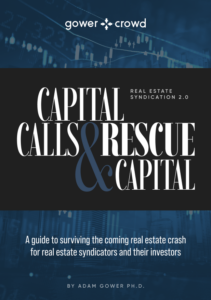The Impact of the Yield Curve Inversion on Real Estate
By Adam Gower Ph.D.
We are headed for a recession, of that there is no doubt, and the much talked of yield curve inversion has been cited as a sure sign. But is it? This article examines the background to and definition of the inversion, and concludes that it is less a sign of the inevitability of recession, and more an indication of the depths to which the next recession may take us.
Core Economic Indicators
A lot happens in the US economy every day. Things change rapidly, but daily changes don’t matter as much as the way the economy is currently trending. Is it going up or going down? How and where should you invest to get the best return on your money and keep it safe? With recent news of changes to the yield curve, it’s a good idea to look at the market and see what it means for the future.
If you’re paying attention to the economy to see which direction it’s going, you’ll be looking at a few specific markers in particular. These are the core economic indicators across any industry and the economy in general. Some industries may have their own indicators, but for real estate they remain the same:
-
- Consumer Spending
- Employment
- Manufacturing
- Economic Growth
Because of how interconnected the global economy is, many people look at these indicators both internationally and domestically to stay ahead of the trends.
Sometimes a slowdown in a significant economy overseas can signal a trend that will happen globally, but this is not always the case. Historically, it’s not an entirely reliable method of gauging future economic trends.
Get access to our FREE weekly newsletter exclusively covering the latest updates from the real estate crowdfunding world
Analyzing the Real Estate Sector
Watching economic indicators is like observing a flock of sheep. They all look like they’re going the same direction, except for a few here and there that are turning or going the opposite way.
Your challenge is figuring out if the rest of the sheep will turn or if they’re going to continue moving forward.
When you’re speaking in the context of real estate, some economic indicators hold more weight than others. Consumer spending is arguably the most important indicator for the real estate sector, as it gives clues about consumer confidence in the economy. As consumer spending moves, the real estate industry tends to move with it.
Consumer spending gives a glimpse into the minds of American consumers, often called ‘consumer sentiment.’ If the negative or pessimistic headlines are getting to consumers, they’ll hold back on spending and this indicator will shrink. If consumers keep normal spending or grow in spending, it’s a good sign they’re not worried about the economy. Worried consumers tend to avoid making large purchases such as in real estate.
Trade discussion, international economy news, tax news, Fed rate changes, and other big headline topics tend to have an impact on consumer sentiment. Although all these topics have been in the news in the US over 2019, it hasn’t had a large impact so far on overall consumer sentiment.
While the word “recession” has been thrown around here and there, the general consensus is that we’re still waiting for the turn and watching for it, but most people are not particularly concerned about it right now. However, economists have been debating about what the current yield curve data suggests about an upcoming recession.
Yield Curve Background
Yield curves are graphs showing the interest rates for short-term and long-term mortgages.
Under normal economic conditions, the yield curve should be moving up from left to right, signifying that short-term adjustable mortgage rates are lower than long-term rates.
This shows that lenders have confidence in the economy in the short term with less certainty about the long term, which is a normal way to view the economy.
When the yield curve inverts, meaning long-term mortgage rates are lower than short-term rates, that indicates that lenders have less certainty and less confidence in the economy in the short-term than they do in the long-term.
Historically, yield curve inversion has been followed by recession at some point. The exact time period between the inversion and the following recession has varied as much as a few months after to even 2 years after. Nonetheless, it’s still served as a strong warning sign for many, and economists from every sector tend to put a lot of weight on the yield curve, whether that’s right or not.
As of mid-late 2019, the yield curve is dancing back and forth between inversion and a regular spread. What does that mean for the real estate market today?
Get access to our FREE weekly newsletter exclusively covering the latest updates from the real estate crowdfunding world
Yield Curve Inversion & Real Estate Today
It may be wise to be on the lookout, but the news, while nuanced, isn't necessarily bad yet. With Fed rate cuts earlier in the year and 10-year rates dropping on the yield curve, those in the real estate sector have taken time to re-evaluate what they’re doing and where they’re putting their money. However, it hasn’t impacted real estate sector growth. In fact, it’s had no noticeable outcomes so far.
10 year money has dropped to sub-4% again providing unprecedented yields for investors acquiring commercial assets with credit tenants at cap rates even just 150bps higher.
Indeed, in the second quarter of 2019, borrowing and lending on commercial real estate in the US went up by 11% when compared to 2018.
Considering that 2018 was a strong CRE year with over half a trillion dollars in multifamily mortgage origination alone, these are promising numbers that, while they don’t suggest a slowdown in US real estate right now, do indicate some overheating.
There are a few reasons why we may not see a slowdown just yet. Firstly, the US dollar has been a stable investment for international investors, especially when compared with other strong currencies that are currently offering low or negative returns. US real estate is stable and yielding well when compared to many international bonds.
Another point to consider is the readjustment we’ve seen from US real estate investors. As the Fed cuts rates and as the 10-year rates on the yield curve go down, investors are looking at other areas of real estate and considering long-term investments rather than short-term projects. Rather than seeing a reduction in investment, what changes have occurred are primarily shifts from one type of CRE asset to another, or recapitalization of existing projects to arbitrage acquisition caps with long term debt rates.
Are We Headed for a Recession?
Heck yes! We are always heading for a recession - the key question is not 'are we heading for a recession,' but 'how long before the next recession hits?'
Looking strictly at the yield curve inversion, recession cannot be said to be imminent. Other indicators are holding solidly in place and yet as we continue to steam ahead at full speed, dark clouds are forming on the horizon that could change this outlook very quickly.
***
Keep watching the indicators and pay attention to external forces like the morass in Europe over Brexit, oil shocks and rising tensions in the Middle East, and the exploding budget deficit.
While the yield curve inversion of itself does not indicate a recession, the impact of falling, or being pushed, into a recession could be exacerbated by the sentiments that create the conditions for the inversion, and be further compounded by the current administration’s economic policies that has driven the budget deficit, predicted to exceed over $1 trillion in 2020, to new highs.
Like any real estate developer knows; you can’t dig your way out of a hole and, as good as it seems at the time to have access to cheaper capital with greater liquidity, excessive debt is always the killer.
If the signs are pointing to a recession, as they clearly are right now, the wise will pull back, conserve resources, and prepare for the opportunities a downturn always presents.
If you have only just started in real estate development, have completed no deals, have no email list, but know you want the freedom and wealth being a real estate developer brings, then I suggest your first step is to start evaluating deals so you can recognize a good one when you see it.
Here’s where you should start. You’ll learn everything you need to know – the different types of real estate, different development strategies, how real estate cycles influence the market, and all about due diligence.
If you want to find deals and raise money for them so you can start your real estate development business, then learning how to conduct due diligence so you can pitch your deals better to investors is a great place to start.
If you’ve already purchased one or more real estate project and are seeing more opportunities than you can finance, then now is the time to start building your investor network so you can finance all your next deals quicker.
You’ve already got some momentum; now start finding and educating prospects about what you’re doing so you can build an email list of people to pitch to when you’re ready to raise money for your next deal.
This is what we build for private clients all the time – it’s called the Investor Acquisition System and you can access the entire program right here so you can find prospects, and convert them into being deep pocketed, repeat investors in your deals.
If you are a seasoned pro with multi-cycle experience, a substantial portfolio, a decent deal pipeline, and find yourself spending too much time raising equity capital because you’re still doing it in-person, then it’s time you put technology to work for you.
The wonderful thing about doing this is that you’re not going to be doing anything different than you’re already doing and, guess what, you’ll never have to sit through investor meetings again.
Sounds crazy I know, but I lay the whole thing out for you in this white board workshop where I personally show you exactly what it takes for you to transform your equity raising into a fully automated, capital raising machine so you can find new investors while increasing commitments from your existing network.






